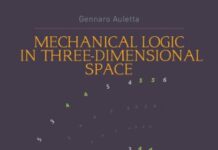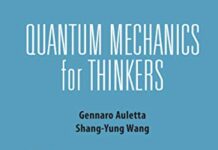
Ebook Info
- Published: 2009
- Number of pages: 757 pages
- Format: PDF
- File Size: 10.00 MB
- Authors: Gennaro Auletta
Description
The important changes quantum mechanics has undergone in recent years are reflected in this approach for students. A strong narrative and over 300 worked problems lead the student from experiment, through general principles of the theory, to modern applications. Stepping through results allows students to gain a thorough understanding. Starting with basic quantum mechanics, the book moves on to more advanced theory, followed by applications, perturbation methods and special fields, and ending with developments in the field. Historical, mathematical and philosophical boxes guide the student through the theory. Unique to this textbook are chapters on measurement and quantum optics, both at the forefront of current research. Advanced undergraduate and graduate students will benefit from this perspective on the fundamental physical paradigm and its applications. Online resources including solutions to selected problems, and 200 figures, with colour versions of some figures, are available at www.cambridge.org/Auletta.
User’s Reviews
Reviews from Amazon users which were colected at the time this book was published on the website:
⭐I disagree with the opinion of the reviewer who likened this very fine, up-to-date and scholarly text to a “mediocre Wikipedia article written by students …”. Personally I had been waiting for a book like this, viz. one providing clear and reasonably detailed discussions of conceptually important, recent developments in the field. This book does just that for a wide set of topics, e.g. density matrix, symmetry and conservation, measurement theory (Schrödinger cats, decoherence, experiments such as delayed choice, interaction free measurement, positive operator valued measure, quantum non-demolition measurement); quantum optics, open systems, state measurement (protective measurement, cloning, measurement and reversibility), entanglement (including, non-separability, entanglement and information, teleportation), and it does so with a minimum of prerequisites given the subject matter.In general I have found the exposition very clear and the pace just right: doesn’t skimp on the formal/math part, has sufficient diagrams and examples to go with the discussion. The book is logically organized, moving from a formally sound, reasonably complete exposition of basic elements in Part I, to more advanced topics in Part II (standard topics plus a chapter on “the measurement problem in quantum mechanics” pp. 277-356) and Part III (standard topics plus quantum optics, the latter of which includes some discussion of geometric phase, viz. the fascinating Aharonov-Bohm effect and Casimir effect), then on to Part IV, which deals with open systems (e.g., the master equation), state measurement (including cloning, reversibility, and quantum state reconstruction) and finally, two chapters on entanglement – one chapter on non-separability, EPR, Bohm, Bell, etc, and the other covering the basics of quantum information and computation.It also includes complete lists of figures, tables, definitions, principles, boxes, symbols and abbreviations; something I find missing in other textbooks but very useful for review. Visually, the book is very nicely produced, important for people like me who are sensitive to such matters.I also greatly appreciate the substantial, up-to-date bibliography as well as the multitudinous footnotes and cross-references. This has allowed me to access the original literature on a topic and read it in conjunction with the textbook, which I have found very satisfying. The authors are also careful to point out various controversies and fine points of interest to those interested in foundational issues. True, this is a very scholarly work. But what is wrong with that? For me, this is a plus. If you want to just learn the standard QM fare of 50 years ago and not concern yourself with more recent foundational issues, then this book is not for you. But if you are a serious student of foundational issues who wants to learn about recent theoretical and experimental work, then I highly recommend this book to you. I have found it more stimulating overall than older “standard” textbooks.However, if you are teaching yourself, it is not a good choice for your first book. What would be appropriate would depend, of course, on your math and physics background. But in general, I think that any of the following would be a good choice: Miller’s very clear
⭐(cf. my review), Zetilli’s somewhat more mathematical / formal
⭐, Townsend’s much less formal but quite effective
⭐.
⭐This is a nice book on quantum theory written from a modern perspective. The discussions on quantum entanglement and the measurement process are superb and enlightening. To gain maximum leverage from this book, the reader should have had a first acquantaince with quantum mechanics,say at the level of the more elementary texts by Griffith or Gasiorowicz.
⭐Answer to “very poorly review ” from a Italian student .Girgio Parisi corriculum :2010 Plank Medal2007 Galileo prize2005 Dannie Heineman prize1999 Dirac Medal (for Altarelli-Parisi equation…)Member of Academy of Science ,USA……………………..
⭐This book reads like a mediocre Wikipedia article written by students who just transcribed equations from their notebook and peppered the text with clumsy comments. I bet the authors wish they could put hyperlinks into books! Unfortunately we’ll have to do with an average of five references to sections and subsections, three footnotes and two directions to other books, per paragraph. Why did CUP publish this? Perhaps it is to make you laugh and cry when you read “in other words,” “in fact,” and “it is evident that” the thousandth time.This is an awful book. Luckily there are many excellent books on quantum mechanics.
⭐This is a marvelous book – up to date, thorough and in the best rigorous but user friendly tradition. I wish I had had this book 10 years ago when studying QM at graduate and post graduate level
⭐Very detailed and covers a lot of content…definitely helped in my research project.
⭐J’attendais plus et mieux ; tout n’y est pas limpide ; les discussions philosophiques sont un peu absconses ; il n’est pas utile de passer un temps fou sur le formalisme des espaces de Hilbert surtout avec ces notations qui compliquent plus qu’elle ne simplifient ; mais beaucoup de choses utiles ; doit impérativement être complété par d’autres lectures c’est dommage .
Keywords
Free Download Quantum Mechanics 1st Edition in PDF format
Quantum Mechanics 1st Edition PDF Free Download
Download Quantum Mechanics 1st Edition 2009 PDF Free
Quantum Mechanics 1st Edition 2009 PDF Free Download
Download Quantum Mechanics 1st Edition PDF
Free Download Ebook Quantum Mechanics 1st Edition



